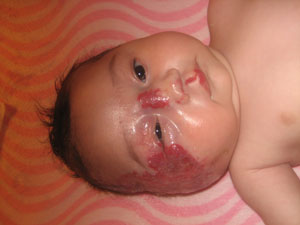
During a routine well-baby checkup shortly after Thea was born, her pediatrician noted a small red spot on Thea’s temple, adjacent her right eye. Colleen , Thea’s mother, recalls, “Our pediatrician knew immediately that the red spot was a hemangioma, and he told us it would grow significantly before it got better. He immediately referred us to a pediatric dermatologist.”
The most common birth defect, affecting about 2% of all newborns, hemangiomas are benign, blood vessel tumors that can appear anywhere on a child’s body, at or shortly after birth, occurring more often in females than males. Hemangiomas typically grow very rapidly during the first year of life, then slowly involute (go away) over the next few years. Typically, about 50% are gone by age 5, 70% by age 7, and 90% by age 9. While present, however, hemangiomas can stretch the child’s skin and cause deformities, particularly of the face, affecting eyesight, hearing and even breathing.
Colleen recalls her reaction to the diagnosis. “My heart dropped. I felt sick to my stomach. The pediatrician told us not to worry. ‘Don’t go online and look it up,’ he said. But of course, I did. And seeing the pictures on the Internet, I felt horrible, scared, overwhelmed.”
The dermatologist started Thea on steroid treatments to try to prevent rapid growth during the proliferative, first-year phase. Soon thereafter, the dermatologist began administering a drug called propranolol, an oral blood pressure medication that has proven to be safe and effective, when used in low doses, in stopping and reversing the growth of hemangiomas in infants. Despite the treatments, Thea’s hemangioma quickly spread to her ears, eyes, nose, throat and tongue. The pressure from the hemangioma adjacent her ear caused her right ear drum to rupture.
Just before Thea’s second birthday, the growth of her tumors began to decline.
Treating Thea’s Hemangioma

During this time, Thea’s parents began researching plastic surgeons. “Those with whom we met offered a wide range of opinions, from doing nothing until she turned 18, to subjecting her to multiple, big complicated surgeries,” says Steven, Thea’s father.
In March 2015, they met with affiliated pediatric plastic surgeon Matthew R. Greives, MD, assistant professor, division of Pediatric Plastic and Craniofacial Surgery at McGovern School at UTHealth, and the director of the interdisciplinary Vascular Anomalies Clinic at Children’s Memorial Hermann Hospital.
“There were so many doctors to choose from,” says Colleen. “Most talked about – but not with – Thea. Dr. Greives, who came highly recommended, spoke with all of us, explaining our options, and proposed what we felt was a more pragmatic approach. His bedside manner really put us at ease.”
In addition to Dr. Greives, Thea’s team included affiliated pediatrician Mark J. Sanders, M.D.; affiliated dermatologist Adelaide Hebert, M.D.; affiliated interventional radiologist Roderick Zvavanjanja, M.D. (“Dr. Rod”); and clinical coordinator Irene “Leanne” Doringo, M.S.N., RN.
In April 2015, Dr. Sanders cleared Thea for surgery at Children’s Memorial Hermann Hospital. Dr. Hebert ablated the dark blood vessels from the hemangioma on Thea’s cheek, to minimize its size and appearance. Then, using Thea’s own tissue that he discovered within her nasal cavity, Dr. Greives created a new nose for Thea, with supporting structure and separate nostrils. As a result of these procedures, Thea has a beautiful, fully functioning nose and only a small scar on her cheek. In her teens, she may require one additional surgery, a rhinoplasty, to release any scar tissue that limits the growth of her nose.
Dr. Greives says, “The aggressive use of propranolol, starting with the initial diagnosis, is now standard protocol and usually prevents hemangiomas from growing. But as with Thea, this is not always the case. In more severe cases, corrective surgery may still be required, to correct deformities caused by hemangiomas.”
Hemangioma, Now Just a Memory
Today, Thea is a very personable and energetic six-year-old. She plays basketball at the local YMCA, excels at gymnastics, and loves cooking. Colleen describes her daughter as “precocious”; Steven says she’s “passionate.” Both agree she’s courageous. And neither will ever forget their family’s difficult journey, especially the pain Thea had to endure. “Fortunately,” says Colleen, “she’s got a personality that can cope.”
“When Thea showed her ‘angel’s kiss’ photo to her classmates, she did so with such confidence,” says Colleen, “that it made the other kids wonder why they didn’t have one.”